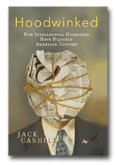Why does 'Composite Girl' surprise anyone?
Get your copy of Deconstructing Obama

___
Jack Cashill's book:
Hoodwinked: How Intellectual Hucksters have Hijacked American Culture

Click here for signed first edition
©Jack Cashill
WND.com - May 3, 2012
In a “Vanity Fair” online excerpt from his forthcoming book on Obama, veteran Washington Post reporter David Maraniss dropped the seeming bombshell that the white “mystery woman” in Obama’s 1995 memoir, “Dreams from My Father,” is a composite.
“Like many characters in the memoir,” says Maraniss, “[Obama] introduced her to advance a theme, another thread of thought in his musings about race.”
Maraniss says this much too casually. When lesser authors improvise with their presumed memoirs – James Frey of “A Million Little Pieces” fame comes quickly to mind – their literary careers come to a crashing halt.
Although Maraniss does identify the Australian woman who provides most of the grist for the composite, that woman, Genevieve Cook, denies her role in the one critical, racially charged scene that justifies her brief presence in Obama’s book.
In “Dreams,” Obama tells of how their relationship came to a bitter end over her failure to understand black suffering. “We had a big fight, right in front of the theater,” writes Obama. “When we got back to the car she started crying. She couldn’t be black, she said.” Cook denies this ever happened.
To his credit, Maraniss asked Obama whether Cook got it right. She had. As an explanation for why he added the story, Obama said, “I thought that [the anecdote] was a useful theme to make about sort of the interactions that I had in the relationships with white girlfriends.”
“My side is I wrote a memoir,” said James Frey in much the same vein. “I never expected the book to come under the type of scrutiny that it has. A memoir literally means my story. A memoir is a subjective retelling of events.”
Indeed, Team Obama is as promiscuous with the facts as Frey. Obama and his muse appear to have created most, if not all, of the racial dramas related in “Dreams.” Here are a few of them.
As a 9-year-old, Obama allegedly visited the American embassy in Indonesia. While waiting for his mother, he chanced upon “a collection of Life magazines neatly displayed in clear plastic binders.”
In one magazine, he reads a story about a black man with an “uneven, ghostly hue,” who had been rendered grotesque by a chemical treatment.
“There were thousands of people like him,” Obama learned, “black men and women back in America who’d undergone the same treatment in response to advertisements that promised happiness as a white person.” This is in 1970, mind you.
Obama’s attention to detail is a ruse. Life never ran such an article. When challenged, Obama claimed it was Ebony. Ebony ran no such article, either.
In “Dreams,” Obama reflects on his own first days as a 10-year-old at his Hawaiian prep school, a transition complicated by the presence of “Coretta,” the only other black student in the class.
When the other students accuse Obama of having a girlfriend, Obama shoves Coretta and insists that she leave him alone. Although “his act of betrayal” buys him a reprieve from the other students, Obama understands that he “had been tested and found wanting.”
In fact, there was a little black girl at Punahou whom friendly Obama biographer David Remnick identifies as “Joella Edwards.” The difference, Remnick admits without understanding its consequences, is that “Barry never rejected Joella.”
Au contraire, as Joella gushes, “He was my knight in shining armor.” As with the story of the unhappily bleached black people, these little racial melodramas smack of willful contrivance.
After leaving Columbia, Obama went to work for what he describes in “Dreams” as “a consulting house to multinational corporations.” He observes, “As far as I could tell I was the only black man in the company.”
Obama does not boast of his racial uniqueness. Rather, in full grievance mode, he considers it “a source of shame.”
As early as July 2005, however, former co-worker and Obama fan Dan Armstrong revealed Obama’s whole account to be a “serious exaggeration.”
Obama did not work at a multinational corporation, but a “small company that published newsletters.” He was not the only black person who worked there. He did not, as claimed, have his own office, wear a jacket and tie, interview international businessmen or write articles.
Obama mostly just copyedited business items and slipped them into a three-ring binder for the company’s customers. What kind of story would that make?
So why would Obama so recklessly make up these stories? The answer is that he may not have been the one making them up. He may have left that job to the muse.
In still another racially charged scene in “Dreams,” “Frank,” the real life Communist pornographer Frank Marshall Davis, slams college education on the eve of Obama’s departure for Occidental.
“Understand something, boy,” Frank tells Obama. “You’re not going to college to get educated. You’re going there to get trained.” Adds Frank, “They’ll train you so good, you’ll start believing what they tell you about equal opportunity and the American way and all that s–t.”
The whole scene rings false. In real life, Davis loved college! He was the rare African-American to get a college education in the 1920s, and he savored every minute of it.
In his memoir “Livin the Blues,” he tells of the richly rewarding years he spent at Kansas State University. The campus was “beautiful,” the students “usually agreeable” and his journalism department “excellent.”
Throughout his memoir, Davis meets fellow black writers and cites their college backgrounds approvingly. He also meets open-minded white college students, whom he sees as the hope for America’s racial future. His college poetry-reading tours on the mainland in 1973 and 1974 are huge successes.
Obama’s muse, Bill Ayers, was less sanguine about the educational experience. “Education is for self-activating explorers of life, for those who would challenge fate, for doers and activists, for citizens,” he writes in his 1993 book “To Teach.”
“Training,” on the other hand, “is for slaves, for loyal subjects, for tractable employees, for willing consumers, for obedient soldiers.” Sound familiar?
In his 1997 book, “A Kind and Just Parent,” Ayers tells of a useful reading assignment from the 1992 book, “The Kind of Light That Shines on Texas,” by black author Reginald McKnight.
The passage in question deals with the travails of Clint, the first black student in a newly integrated school, who rudely tries to distance himself from Marvin, the only other black boy in the school, and feels ashamed about it.
That sounds familiar too, come to think of it.
Webmaster's Note: Jack Cashill's Book-TV presentation of "Deconstructing Obama" can be viewed at http://www.c-spanvideo.org/program/298382-1
Editor's note: For a more complete account of this phenomenon, read Jack Cashill's amazing book, "Hoodwinked: How Intellectual Hucksters Have Hijacked American Culture.

